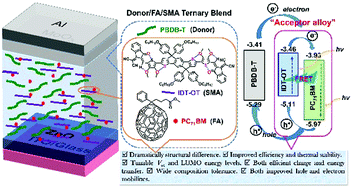A small-molecule/fullerene acceptor alloy: a powerful tool to enhance the device efficiency and thermal stability of ternary polymer solar cells†
Abstract
Along with the rapidly increasing power conversion efficiency (PCE) of polymer solar cells (PSCs), the stability of PSCs has become one of the crucial issues for the commercial application of this technology. Ternary PSCs exhibit great potential in improving the device efficiency and stability. However, the main cause behind the improvement in the efficiency and stability has been a lack of in-depth investigation. Moreover, the basic working mechanism of ternary solar cells is still ambiguous and it is urgently necessary to further understand it. Here, a small-molecule acceptor (SMA) IDT-OT was developed and introduced into a binary system containing polymer donor PBDB-T (donor) and fullerene acceptor (FA) PC71BM to construct donor/FA/SMA ternary PSCs. The results reveal that the incorporation of IDT-OT into the PBDB-T/PC71BM binary system can improve the PCE up to 9.09% and enhance the thermal stability of the ternary PSCs relative to all the binary systems. In-depth investigations indicate that the enhanced device performance and stability are closely related to an intermixed small-molecule/fullerene acceptor alloy formed by IDT-OT and PC71BM in which the structural nature of the two acceptors is remarkably different. This distinctive alloy system is verified via investigating the dependence of the LUMO energy level and open-circuit voltage on the weight ratio of IDT-OT in the acceptor blend and the miscibility of the two acceptors by morphological characterization and water contact angle measurements. This small-molecule/fullerene acceptor alloy phase is beneficial for improving charge dissociation, collection and transport as well as the carrier mobility, and suppressing bimolecular recombination, thus leading to the increase of Jsc and FF of the ternary PSCs. Interestingly, photoluminescence and donor-free device performance studies demonstrate that there exists not only efficient charge transfer but also Förster resonance energy transfer between PC71BM and IDT-OT, which has rarely been found in previously reported ternary PSCs. Moreover, we suppose the stable active layer morphology benefitting from the formation of this small-molecule/fullerene acceptor alloy as the main reason behind the observed improvement in the thermal stability of the ternary PSCs. This work suggests that introducing an SMA into an FA to form a small-molecule/fullerene acceptor alloy could be a powerful tool to realize high-performance and stable PSCs.



 Please wait while we load your content...
Please wait while we load your content...